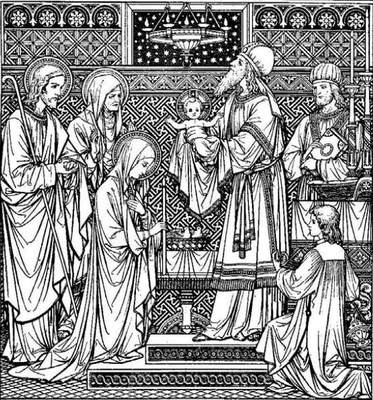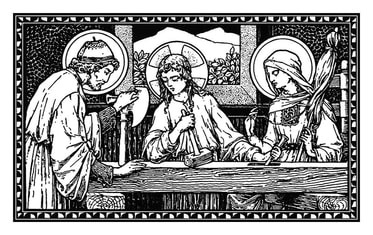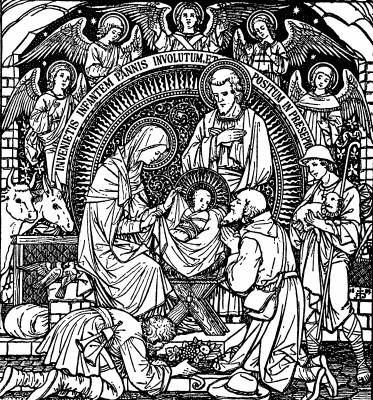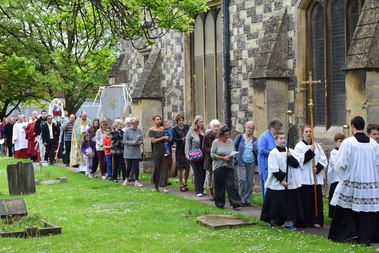 Luke 2:22-40 ‘A light to enlighten the pagans and the glory of your people Israel.’ (Luke 2:31-32) Last week during the notices I made a passing comment on how many traditions the Church treasured for centuries have been thrown away like the baby with the proverbial bath water. This streamlining of traditions can sometimes be a positive thing, but more often than not it has been prompted by a misguided belief that progress has made certain things redundant. Even the today’s feast has undergone drastic changes. Although it is still nicknamed Candlemas, many of the ceremonies have gone and this celebration has been completely rebranded to reflect a shift in people’s perceptions of childbearing, and to put more emphasis on the Lord Jesus, who – though an infant – is at the very centre of the gospel reading. Slightly older members of our congregation might remember Candlemas being called “The Purification of the Virgin Mary”, but today it is called “The Presentation of the Lord to the Temple”. Back then the Feast of the Purification went hand-in-hand with something called “the Churching of Women”, a service at which mothers were blessed after giving birth and formally readmitted into the liturgical life of the Church. But now, the Churching of Women has been largely discontinued by most Christian denominations, and so has the ancient name of this Feast. Back then the Feast of the Purification was a special festival in honour of our Lady; but now our attention is drawn especially towards her Son who enters in his own Temple at Jerusalem as God-made-flesh for the first time. Reflecting the gospel reading, now our Lord is at the centre of Candlemas; and he is once more the reason for our celebration. The old focus of Candlemas was Mary and Joseph coming to the Temple to fulfil the requirements of the Jewish Law. Now the liturgy calls us to look upon the infant Jesus with the eyes of Anna and Simeon, and to see in him light and salvation. One ancient tradition, however, survives; the blessing of candles. About one thousand years ago Saint Anselm, Archbishop of Canterbury, preaching on this feast said of these candles, ‘The wax which is the product of the virginal bee, is the Flesh of our Lord; the wick, which is within, is His Soul; the flame, which burns on top, is His divine nature.’ And a few moments ago, we were holding the same lit candles, the same symbol of Christ, like the people in Anselm’s congregation did, and like countless generations of Christians before them. One of the reasons for the enduring popularity of this tradition is found in our gospel reading where Simeon describes Jesus as ‘a light to enlighten the pagans’ meaning that, through Jesus, God is revealed to all, not just God’s ancient people. Through him – our Emmanuel, God-with-us – no-one is barred, and in him everyone is given access to God. Then, Simeon also says that the Jesus has come ‘so that the secret thoughts of many may be laid bare’; meaning that, in his brightness, the Lord is able to bring to light our innermost thoughts, even those things we hide from ourselves. So our candles are visible tokens of the spiritual enlightenment Jesus brings. They remind us that for us nothing should be more vital than the light of Christ; that we must learn to rely on his light while we journey on, rather than our sense of direction; and that we should follow the road that Christ illuminates for us until we reach our home. Traditions may come and go. A few may be discontinued for good reasons; others may just fall out of fashion only to be revived later on. But what remains of Candlemas has survived unchanged because it is a practical representation of Christ – the light at the centre of our celebration and, more importantly, the light that must shine at the centre of our hearts. Lead, Kindly Light, amidst th'encircling gloom, Lead Thou me on! Lead, Saviour, lead me home in childlike faith, Home to my God. To rest forever after earthly strife In the calm light of everlasting life.
0 Comments
 Luke 2:22, 39-40 ‘The child grew to maturity, and he was filled with wisdom; and God’s favour was with him’ (Luke 2:40) I chose to read the shortened version of our gospel this morning for two reasons; first we are going to encounter this passage again in a few weeks’ time at Candlemas, and secondly, the main point Luke wants to make this morning is that Jesus, the eternal Son of God the Father, grew up and was formed in a human family – that Holy Family. Today’s celebration can teach us something about our faith. Falling on the Sunday in the Octave of Christmas, the Feast of the Holy Family is a natural extension of Christmas Day itself, the next step in unfolding the mystery of the Incarnation. God the Son chose to become “God-with-us”, he chose to become incarnate in Mary, he chose to be born in humble conditions; then he also chose to grow up as children do within the ordinariness of a human family. In this Holy Family, God humbled himself to learn obedience to earthly parents and how to relate to other people. Why? In his loving purpose to redeem us in Jesus Christ, God assumed our flesh, our nature, and all the triviality of our being human; so he assumed also the tricky dynamics of human relationships, including family life. So in honouring the Holy Family we see how Jesus redeemed everything about our lives, even our sometimes dysfunctional families, showing us a better way, a holy way, to be family… A better way to be family… These are loaded words. I understand it. And on this feast there is always a strong danger for preachers to hold up the Family of Nazareth as the divine blue print for the ideal set up of a Christian family – mummy and daddy are happily married, and their child is so adorably well-behaved that even a carol sings “no crying he makes”. I say a danger because a family so idealized could be a stumbling block for many of us, rather than an inspiration. Besides, in practice families don’t always work like that, and our domestic arrangements are, more often than not, rather more complicated that the ones faced by the Holy Family, even with all their travels as refugees, and their having to lodge in a stable – mummy and daddy are not necessarily happily married, or together at all, and sometimes the children can be a bit of a handful to say the least. So, what would the Feast of Holy Family teach us, teach our families, today? Rather than a blue print for our domestic set up they can become a spiritual model for our families in the sense that in the home of Nazareth we see an “authentic school of the Gospel” (JPII & Francis, Angelus Messages on 30 Dec 2001 & 27 Dec 2015), where Mary and Joseph, gathered around the living Word of God, lead their household in a way that is intentionally centred on faith and commitment to God. We must look beyond the very unique features of the Holy Family’s domestic arrangements to see how Jesus, Mary, and Joseph can teach every home to be or become a “domestic church” (Lumen Gentium)– a community where the Christian habits of love, faith, and hope are practiced and taught; a haven of unconditional affection, a place where – as the introduction to the wedding service says – ‘each member, in good times and in bad, can find strength, companionship and comfort, and grow to maturity in love.’ May the prayers of the Holy Family help us to put God at centre of our homes, and gain for us the grace we need to imitate their devotion to one another in our relationships. Amen.  Luke 2:1-14 ‘I am bringing you good news of great joy for all the people: to you is born this day a Saviour, who is the Christ, the Lord.’ (Luke 2:10-11) Earlier this week a BBC programme claimed that up to 25% of people who wouldn’t normally class themselves as religious believe in angels. So, it seems that even in our post-Christian, secular society many people still retain something of the time-honoured belief about these heavenly creatures. And the Christmas story we come to celebrate tonight is full of them. Reading first couple of chapters of Luke’s gospel we encounter angels everywhere – speaking, singing, catching people by surprise in the ordinariness of their lives, and bringing to them messages from God. They pave the way, as it were, for the Christmas story to unfold; as if directing a large theatre production, the divine drama of the Incarnation, they invite each character to play their part… They speak to the Virgin Mary, they speak to Joseph, at the beginning of the book they even speak to Zachariah about the birth of John the Baptist, and tonight they speak to us… ‘I am bringing you good news of great joy’, says the angel; and confronted by these news, what should our response be? If anything, 2017 has been the year of “Fake News”; at best these have been stories where the truth was side-lined in order to read as sensational headlines, and at their worst fake news have been clever pieces published to deceive or gain some dishonest advantage. So, when we hear again a two-thousand year old Bible story about heavenly creatures delivering incredible news, a few people, now perhaps more than ever before, may quite reasonably remain a little sceptic. But unseen, unheard, the angels speak to us tonight – the words of the gospel reading and the verses of our Christmas carols re-echo for us the first song they sang to the shepherds about the birth of Jesus Christ. Unseen, unheard, the angels speak to us in this place, and they bring us messages from God, true news about a child born for us. Unseen, unheard, the angels come to worship with us that child who is their King. The Bible story speaks of shepherds living in the fields; people with whom we have probably little in common. But we have already travelled in the cold winter air, like the shepherds did, to worship the Christ-child. And the angels’ message for us is about another journey that lies before us; to travel yet further to a spiritual Bethlehem, to travel with our hearts to Jesus, to see him with in humble condition in which he was born for us, and to invite him to enter our lives – tonight – that he might live with us, and us for him. ‘I am bringing you good news of great joy for all the people: to you is born this day a Saviour, who is the Christ, the Lord.’ Whether we remain sceptic about angels, or we take all news with a large pinch of salt, the good news proclaimed tonight remains; our salvation, our peace, our future lies wrapped in cloths in a stable, where God himself has come to be one of us. Like the shepherds, it is up to you to reach out to meet him. Luke 1:57-66, 80
‘His name is John.’ Luke 1:63 I guess that for many people, including the evangelists Matthew and Mark, St John the Baptist is more easily remembered in connection with his death, when his severed head was delivered on a platter by King Herod to his stepdaughter. But, taking our inspiration form Luke’s gospel, today we celebrate his birth of St John, the only other saint apart from the Virgin Mary, whose birthday is kept by the Church as a solemnity. This is because John’s birth, like that of Our Lady, signalled the end of the Old Testament era, and the beginning of the New Covenant between God and humanity in the person of Jesus Christ. From its very beginning John’s story assumes various similarities with previous Old Testament texts. For example, we have just read in the gospel that John is born from elderly parents, who many considered forgotten by God on account of their childlessness. His birth comes as a vindication of Zachariah and Elizabeth’s trust in God, much as the births of Isaac and Samuel did for their parents before them; a vindication expressed in the child’s own name, John, meaning “God is gracious” or “God has shown favour”. But this is not all. Even as an infant, John challenges the social norms of his time when these become a distraction from God; for example, the name “John” is not in line with the traditions of the elders – something that, as we have read, causes much perplexity. Later on, John does not follow in his father’s and ancestors’ footsteps as a priest at the Jerusalem Temple, but he goes off – probably at a young age – to live in the desert in order to devote himself more fully to God and to prepare himself to be ‘the voice of one crying out in the wilderness: “Prepare the way of the Lord”’ (Mark 1:3). As an adult, John embraces his call to prepare the people of Israel for the arrival of Jesus. He continues to be an almost contradictory figure, who at the same time challenges injustice and immorality with really tough words, but who also offers God’s loving forgiveness, and a second chance, to all those who step into the Jordan to be baptised. However, perhaps John’s most striking features are his personal humility and deep commitment to his vocation. We see this most clearly later in the gospels. When people begin to wonder whether or not John is the Christ he simply dismisses their speculations, and he points people towards Jesus. He says, ‘Among you stands one whom you do not know, the one who is coming after me; I am not worthy to untie the thong of his sandal’ (John 1:27). St John the Baptist holds a place of special honour in the church; he is acknowledged as the last of the prophets – standing, as he did, on the watershed between the Old and the New Testaments – and, more importantly, he is the precursor, the forerunner, the one who went ahead to prepare the way for Jesus and his Kingdom. Indeed, the fourth gospel describes him, as a ‘man sent by God… who came as a witness to testify to the light, so that all might believe through him’ (John 1:6-7). But perhaps because of this, John could be easily set aside as one of those key saintly figures that have little to teach us in practice. Yet, his example of faith should inspire all Christians to prepare the way for the Lord in our world – to be the ones sent by God as witnesses to the light, so that all might believe through us. This is all the more true now than ever before, when in our post-Christian society so many people do not know the Lord at all. Our vocation then, like John’s, is to challenge the injustice of our times, to subvert those popular customs that distract from God, to embrace the Christian life to which we were all called, and to point people towards Jesus Christ – the only source of true life.  Luke 1:39-56 Filled with the Holy Spirit, Elizabeth said, “Of all women you are the most blessed and blessed is the fruit of your womb.” (Luke 1:42) In ancient times the month May was dedicated to springtime celebrations of nature, agriculture, and in many ways of motherhood… to this day several countries around the world keep Mother’s Day in May. Many different cultures, from the Romans to the Celts, associated May with fertility and with life as well. And with the advent of Christianity, the Church claimed these celebrations (Christened them, in a sense) in honour of the Virgin Mary. Out went the yearly May queens and the goddesses of the pagans, and Mary became the new queen of this month, as one old hymn sung, O Mary, we crown thee with blossoms today, Queen of the Angels and Queen of the May. But how did we get here? Mary is certainly not a goddess – we venerate her, but we do not worship her; she is our sister in our humanity, and her physical motherhood generated only one child. Then, so to speak, what is the fuss about? The Virgin Mary is the Mother of God, her only child is the Lord Jesus, and as such she is Mother of the One who has come into the world so that we ‘may have life, and have it to the full’ (John 10:10). Through her we have the Saviour; through her we encounter Jesus who is our life, and this is why today, this month, every day we celebrate her and we seek her prayers, remembering what the gospel says of her, “all generations will call her blessed” (Cf. Luke 1:48). But amidst our celebrations we ought to remember that sadly too many Christians still see Mary as the reason for unhappy divisions, as “the thing” that separates believers one from the other. But Mary is not a thing, and most definitely she is not some kind of theological wedge driven in to separate brothers and sisters in Christ. Rather, as the Mother of the Lord Jesus she is also the Mother of all Christians – of all believers of every denomination. And what quarrelling siblings would truly think their own loving mother, a mother who bids them to make peace, as the reason behind their estrangement? Let us meditate on the today’s gospel, and particularly on the words of St Elizabeth, ‘Of all women you are the most blessed and blessed is the fruit of your womb’. Mary cannot a cause of division; rather, as we are able to find unity in the blessed fruit of her womb as Christians, so we could find unity in Mary’s own very self too… if only we were humble enough to admit that we have used her as an excuse to mask our self-serving divisions. But let me give you an example of the unity we already find in Mary. Earlier this month five bishops from the Church of England took part in the centenary celebrations of the first apparition of the Virgin Mary to a group of children near Fatima, in Portugal. The very presence of a number of our bishops at such an event would have been truly unimaginable hundred years ago, when Anglicans and Roman Catholics were bitterly divided, but such is the powerful influence and intercession of the Virgin Mary. So, as we mark our May Devotions today, as we prepare for our procession and our singing in honour of the Blessed Virgin, let us ask Mary to pray for the Church, for the unity of all her children, and that everyone may experience life to its full in Jesus, the blessed fruit of her womb. Amen. Luke 24:13-35
He took the bread and said the blessing; then he broke it and handed it to them. And their eyes were opened and they recognised him. The story of the road to Emmaus is a familiar one for many Christians, and it is a popular illustration of Jesus’ interaction with the disciples after his resurrection from the dead. This story is set on the evening of Easter Day when a couple of dejected disciples find themselves on the road leaving Jerusalem. To their minds Jesus is dead, dead, and gone, and the rumours about his body having disappeared from the grave prove too much to take. They are leaving; leaving everything behind, walking away from their hopes and their dreams. In the opening scenes of the Lord of the Rings Gandalf rebukes Frodo for his lack of faith saying, ‘A wizard is never late, nor is he early. He arrives precisely when he means to.’ Now, although Jesus is by no means a wizard, his unexpected visit to the disciples does remind me a lot of this phrase. At the lowest point in in the disciples’ lives, when it seems too late for faith to be revived, Jesus makes a timely appearance, and eventually breaks down the dejection and the sorrow that prevent the disciples from recognising him, transforming their disappointment in uncontainable joy. Luke often tries to locate the stories of his gospel with some degree of accuracy. But in this case we are not told by the evangelist where the meeting between Jesus and the two disciples took place; all we know is that it was somewhere at a short distance from Jerusalem, on a dusty road which the sorrows and the disappointments the disciples bore made even more slow and difficult to walk. Yet, this Luke’s inaccuracy about a specific location proves to be for our benefit; so that we may be able to relate a spiritual meaning of the story to our lives. We may not know where the village of Emmaus was but ‘the road that leads there is the road every Christian, every person, takes.’ (BXVI) At various points dejection towards the Christian life can take hold of us, or maybe serious doubts can make the practice of religion more taxing. It is in these moments that we must seek the presence of the Risen Lord Jesus in the twofold ways highlighted in our gospel. First, we see that as Jesus walked along the road with the disciples he explained to them the Scriptures pointing out to them all those things that the Old Testament, and particularly the prophets, foretold about him. Likewise we ought to nurture our faith with regular study of God’s Word, through prayer, discipleship courses, and reading religious publications, so that our faith may become grounded, rooted, in the soil of the Scriptures. Secondly (and more importantly, I should add), we see in our reading that the disciples only recognise the Lord for who he really is in the moment of self-giving, in the moment in which he breaks for them the bread of eternal life. ‘The eyes of those who receive this … are opened that they should recognise Christ; for the Lord’s flesh has in it great and ineffable power’ (Theophylus). We too must approach Holy Communion as often as we can in the same way; as the encounter with Jesus who gives himself to us so that we may recognise him as the Lord, living and present in our midst. The story of the road to Emmaus is a familiar one for many Christians, but it is more than just the narration of something that happened after Jesus’ resurrection. It is a simple pattern we readily apply for living the Christian life in the best way, by reading and praying the Scriptures, and receiving the Eucharist. And if we follow this pattern, our faith too will be transformed in the uncontainable joy of knowing the Risen Lord. Luke 10:25-37
Which of the three men, do you think, was a neighbour to the one who fell into the hands of the robbers?’ The lawyer replied, ‘The one who showed him mercy.’ Jesus said to him, ‘Go and do likewise’. A couple of weeks ago as we were planning this service, we decided to steer clear of the word “community” as the theme for this celebration. And there are very good reasons for this. “Community” has become a buzzword to signify everything and anything that might bring or hold people together. Here at All Saints’ we are responsible for this as anyone else, given that the description on our website says, ‘A friendly and welcoming Christian community…’ But by overusing, and misusing, the word “community” we deprive it of any real meaning. Yet, the gospel encourages everyone (Christians and otherwise) to consider a different approach towards bringing people together; not in terms of being a community – although the Church could be understood as a community of sorts – but in terms of coming together as good neighbours. This approach is somewhat different from what we have been used to hear over the last few decades, and it is definitely more challenging to embrace. In the gospel passage that the Mayor has kindly read for us Jesus gives us an example of how belonging to a community can sometimes hamper the flourishing of other individuals. We see this in the priest and Levite who belong to the same community that served in the Jerusalem temple, and led the worship for the people of Israel. These two characters, seeing the man left for dead on the side of the road, cross over to the other side in order not to be defiled by coming in to contact with him, and so lose their sense of belonging to their own community. “He is not one of us”, the priest may have said to himself. “If I become ritually impure by touching this man, my community would banish me from service”, the Levite may have thought. Their strong sense of belonging to a certain group of people prevents them from helping a stranger they encounter, giving him the time of day, and showing mercy towards his sorry state. Their inaction, which from their point of view is perfectly justifiable, becomes for us an example of how an inward-looking impersonal idea of community can actually do harm, by setting membership as a higher priority than doing good to others. But to this example of strict adherence to a community Jesus contrasts the behaviour of another man, who would be cast as “the Good Samaritan” happily ever after because his actions. This remarkable man is not part of Israel’ society, in fact he and his fellow Samaritans are despised by the Israelites and considered the least trustworthy people around. Yet, he is the one who helps the man in his troubles, cares for him, and gives him back his human dignity; he sets aside his belonging to any specific community in order to help a fellow human being needing his attention. In short his is the one who acts as a good neighbour. The priest and the Levite are also neighbours in the sense that they find themselves in close proximity to the poor man, but they are bad ones and they do not do anything to help. The gospel here teaches us that being good neighbours is something that transcends any idea of community each own of us might have; crucially it goes beyond religious creeds, political affiliation, nationality, or everything else. Being a good neighbour is about seeing the person next to me for who they are; another human being endowed with infinite worth, and, as such, seeing them also as worthy of my time, dedication, and care. Our town is changing rapidly but this is by no means the first time that dramatic changes have altered the appearance and dynamics of this place. Indeed the town has been transformed many times beyond recognition since it started out as an Anglo-Saxon village over one thousand years ago. Nevertheless, as new roads and infrastructures are built and new people come to live here we, who already live here, have an even bigger chance to show ourselves as good neighbours to newcomers and old residents alike. The gospel poses us an indirect question. What kind of neighbours do we want to be? Ones who care only for likeminded people, for members of our own little communities? Or ones who are there to help anyone we may find on our way? The likelihood that everyone in Houghton will be part of the same community (whether through creed, nationality, or ethnicity) is very small indeed. But by learning to be good neighbours we will learn how to bring people together in a broader, more personal and lasting way… one small act of mercy, one cuppa, one generous offer of help at a time. |
Archives
June 2020
Categories
All
|
 RSS Feed
RSS Feed


